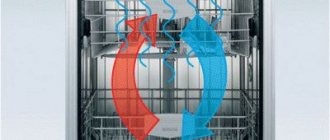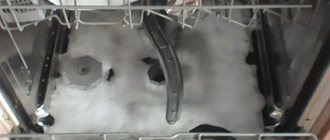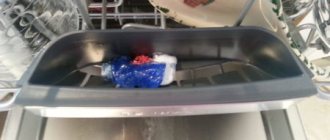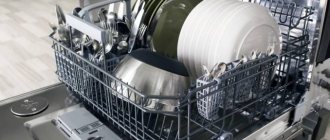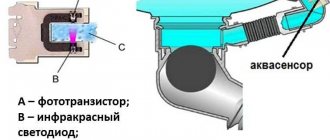In hardware stores, customers are often faced with the question: what type of dishwasher drying is best? Depending on what the buyer values most: speed, energy savings or new technologies, one or another type and class of drying used in the dishwasher will suit him. Let's try to understand in more detail what the advantages and disadvantages of each of them are.
Condensation type of drying
Condensation drying in the dishwasher has been around for quite some time. This type was used in the very first models of dishwashers with dryers due to the simplest mechanism of action. The condensation process occurs as follows:
- At the very last stage of the washing program, clean dishes are doused with boiling water.
- The resulting vapors settle on the upper cold walls of the machine. There they condense back into water droplets.
- Drying of dishes occurs in conditions close to natural.
As a result, the process of moisture evaporation proceeds rather slowly, and marks are often visible on the dried dishes. Meanwhile, condensing dishwasher models have a lower price compared to others. Another advantage is their low power consumption.
Condensation
This type of drying is the most common. Drying of dishes in condensation-type units occurs naturally due to the temperature difference:
- Clean dishes are washed with almost boiling water.
- Hot steam, in contact with the cold walls of the dishwasher, condenses and turns into droplets of water.
- The resulting condensate drains and is then pumped out through the drain hole with a special pump.
The condensation type of drying in a dishwasher has a number of advantages, which include complete silence and efficiency (the unit does not work while drying cutlery and does not consume electricity). Built-in dishwashers with condensation drying are cheaper than their counterparts with turbo drying or zeolite.
This option also has disadvantages. Unattractive stains and drops of water may remain on the surface of plates and glasses, which will have to be removed manually. In addition, it takes several hours for the dishes to dry completely. Therefore, experts advise loading cutlery in the evening so that you can get dry dishes in the morning.
Turbo drying mode
The design of dishwashers with turbo drying is more complex. In addition to the usual parts, they have a heating element for producing hot air and a fan for blowing wet dishes. Turbo drying proceeds in the following way:
- The heating element and fan, which are located in a chamber protected from moisture, provide a continuous supply of hot air.
- This air stream continuously blows on the wet dishes and dries them.
It’s not difficult to guess that a dishwasher equipped with a turbo dryer copes with the task much faster: the model is good for those who want to get the fastest results. However, you will have to pay much more for such equipment than for a model with a capacitor, and it will draw more electricity.
Intensive heat exchange drying mode
In order to make dishwashing machines a little cheaper, manufacturers decided to use the laws of physics of heat exchange processes for the drying process in some models. This is how machines with an intensive type of drying appeared. The principle of their work is as follows.
- Water enters the cold chamber of the water collector, and air enters the adjacent chamber through special openings.
- Due to the temperature difference between the water collector and the walls of the washing cabinet, a pressure difference arises, which forces the incoming air to circulate.
- Intense air movement dries out moisture on dishes.
Thus, in a dishwasher with a heat exchanger there is no heating element and fan. An improved device, which appeared relatively recently, made it possible not only to reduce the cost of the device, but also to ensure that it consumes as little electricity as possible.
Dishwashers: 3 drying types
A good dishwasher should completely relieve the housewife of the need to fuss with plates and cups. Well, perhaps, let its owner load and then unload them after washing and drying. Speaking of the last one. A modern dishwasher can use one of three types of drying:
- condensation;
- turbo;
- intense.
Each of them has its own advantages, so it is very difficult to say which type is better. It all depends on what is important to you. Let's look at them in more detail.
Condensation drying
This is the simplest and cheapest type of drying. With it, dishes simply dry naturally in the dishwasher. To speed up the process, at the very end of the wash cycle, plates and cups are doused with very hot water. The steam rises up and settles on the walls of the machine, the temperature of which is lower than in the washing cabinet.
The whole process takes quite a lot of time, so it is better to choose this type if you are not going to rush anywhere. The ideal option is to turn on the wash cycle in the evening, then by morning all the dishes will definitely be dry. True, there may be stains on the plates and cups.
Turbo drying
Here the dishes are not just dried, but also constantly blown with hot steam. Especially for this purpose, the dishwasher has a built-in fan and heating element. As a result, the drying process is much faster. True, due to the operation of additional elements, excess electricity is wasted. One washing cycle with a turbo dryer will cost you much more than a cycle with a condensing type.
Turbo drying is most often used in expensive models. This is due to the need to find a place for a special fan and protect it while the machine is operating. However, recently manufacturers have learned to add it to budget cars, so if you wish, you can find a model that is suitable for the price.
Intensive drying (with heat exchanger)
Intensive drying has appeared quite recently. Apparently, the manufacturers took into account the advantages and disadvantages of the previous two types and decided to come up with something in between. In intensive drying with a heat exchanger, air also circulates inside the wash cabinet, speeding up the drying process of the dishes. However, this does not happen due to the fan, but due to the difference in pressure.
There are special holes on the dishwasher body next to the water collector to collect air. Since it is hot inside the cabinet and cold in the water collector, a difference in pressure arises, due to which the air circulates, blowing the drying dishes.
Which is better?
The answer is simple: what suits you is better. Is saving energy important? Choose condensation or intensive type. Do you keep track of time? Buy a machine with a turbo dryer.
When choosing, be sure to pay attention not only to the type, but also to the drying class. The letter “A” means that the dishes will be absolutely dry, without a single drop. The letter “B” means that in some places moisture will still remain and will have to be removed manually. Of course, a car with the first class will cost more than with the second.
Approach your choice consciously, and then only joy from your purchase awaits you!
Zeolite drying
This type of drying in dishwasher models was invented and introduced recently. The working agent responsible for the process is the mineral zeolite. Technically, the drying process is implemented as follows: a special niche (container) for zeolite is organized in the tray. The mineral has a unique property: it actively absorbs moisture from the environment, while releasing a significant amount of heat. This heat goes into the main chamber of the dishwasher and works as a second drying factor: warming the dishes inside. The advantage of this method of drying dishes is the absence of water vapor when opening the dishwasher door at the end of the cycle.
The zeolite mineral is not subject to wear, its properties are not lost or reduced over time. The main and, perhaps, the only drawback of dishwashers with zeolite drying is their cost. The mineral is installed only in premium class devices; the minimum cost of such a machine is 45 thousand rubles.
Condensation drying
This is the simplest and cheapest type of drying. With it, dishes simply dry naturally in the dishwasher. To speed up the process, at the very end of the wash cycle, plates and cups are doused with very hot water. The steam rises up and settles on the walls of the machine, the temperature of which is lower than in the washing cabinet.
The whole process takes quite a lot of time, so it is better to choose this type if you are not going to rush anywhere. The ideal option is to turn on the wash cycle in the evening, then by morning all the dishes will definitely be dry. True, there may be stains on the plates and cups.
Drying class
When choosing a dishwasher, you need to understand that dryers differ not only in technology (physical principles applied), but also in classes that characterize quality and efficiency.
According to the generally accepted standard, the drying class has indices in the Latin alphabet from “A” to “G”. This marking is sometimes indicated on the body of the device, and always in the operating manual and passport.
The quality and efficiency of drying is described by the ID index. It has a numerical value ranging from 0 (the lowest drying quality or no drying) to 2 (the most efficient drying). Each drying class corresponds to a certain range of ID index values.
The ID index is determined by assessing the number of drips and wet areas, the area of which does not exceed 50 sq.cm. If there are 1-2 undried locations, the ID drops to one, with more drying defects it drops to zero.
What type of drying to choose
To summarize, let’s define the main criteria for choosing the best dishwasher dryer.
- Intensive and condensation drying are available in models of different classes, starting with the most inexpensive. The drying process itself is also not energy-intensive. This is an option for those who are not willing to pay extra to get perfectly dry dishes at the end. The disadvantages of these options are residual moisture on plates and cups and the time it takes to complete the cycle.
- Turbo drying occurs faster and its quality is higher. But it spends quite a lot of electricity. This type of drying will be a good choice for those for whom time is more valuable than money.
- If the budget does not have strict restrictions, then the best choice is a dishwasher with zeolite.
The best manufacturers are constantly improving technology, trying to overtake their competitors. Innovative technologies are constantly appearing on the market. Thus, Electrolux introduced the AirDry system into its PMM models. She opens the machine door at the end of the wash and rinse cycle. Drying proceeds as if the dishes were placed to dry on the table: due to natural weathering. It is economical, efficient and hygienic.
Types of drying
Now that it is clear how to calculate the mysterious-sounding parameter drying efficiency index and determine the class of a product, it’s time to move on to consider how designers put theory into practice.
The dishwasher is equipped with the following drying options:
- Condensation
- Active.
- Turbo.
The varieties are listed in order of increasing energy consumption. Condensation drying occurs in a semi-natural way. The moisture evaporates on its own, collecting on the heat exchanger or the inner walls of the chamber. The drops flow down in streams. Condensation drying delays the process to the maximum, energy consumption is close to zero.
There are no visible processes happening; from the outside it looks like the dishwasher has finished working, but does not turn off. In reality, the equipment is simply waiting for the plates to dry.
Active drying is based on air circulation. Moist hot streams rise upward, enter the heat exchanger path, where drops settle on the cold walls of the channel, and the air, under the influence of natural processes, falls down the pipe and re-enters the dryer.
A minimum of energy is required to remove the generated heat; energy consumption increases slightly. Active drying in the dishwasher will be the golden mean. This reduces the full cycle time.
The last mode is considered forced air blowing of the dishes. As you know, it dries faster in the wind; moisture is carried away by the passing stream. Turbo drying in a dishwasher shortens the cycle as much as possible at the cost of additional energy consumption. This option is indispensable when maximum speed is required.
Condensing or capacitor type
This is one of the first dryers that appeared in dishwashers; it is still used in Bosch and Milli models. Some manufacturers mark it as turbothermic or static.
The dishes dry naturally, which saves energy. At the end of washing, the devices are doused with hot water, then the hopper door begins to smoothly open. Due to the temperature difference, condensation collects on the walls of the compartment, which subsequently flows into a special compartment.
+ saving resources, the result is satisfactory.
- long wait, plates can take a day to dry.
BoschSMV 40D20
The built-in machine will provide excellent washing and drying of dishes. Capacity for 13 sets, i.e. dinner for a large family and the arrival of guests will not burden the hostess - all the dishes will be washed perfectly.
Dishwashers from Bosch are distinguished by high build quality and performance. This model has a useful “1/2 load” mode. Cost from 23 thousand - the optimal ratio of quality and price.
Flavia BI 60 KAMAYA
A spacious machine for 14 sets, very economical (A+++), not noisy during operation. The advantages include 8 operating modes. The dishwasher is completely protected from leaks and power outages.
Express mode technology leaves much to be desired - reviews indicate incomplete drying in this mode. Otherwise, they find only advantages. The price for Flavia is from 27 thousand rubles.
Siemens SR 64M006
The capacity of this unit is up to 8 sets; it will wash dishes from 3-5 people perfectly. The number of programs is standard, the case is protected from leaks, there is child protection and other useful modes.
